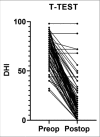Endolymphatic duct and sac decompression: A new technique for Ménière's disease treatment
- PMID: 36324905
- PMCID: PMC9610447
- DOI: 10.25259/SNI_187_2022
Endolymphatic duct and sac decompression: A new technique for Ménière's disease treatment
Abstract
Background: The present article aims to introduce the endolymphatic duct and sac decompression technique (DASD) and to give a spotlight on its benefits in Ménière's disease (MD) treatment.
Methods: Eighty-two patients with intractable MD which met the inclusion criteria were recruited and underwent DASD. This technique allows a meningeal decompression of the duct and the sac from the posterior cranial fossa to the labyrinthine block. The authors considered as main outcomes, the change of the dizziness handicap inventory (DHI) results, with the evaluations of the three sub-scales (Functional scale, Physical scale, and Emotional scale); ear fullness and tinnitus change on the perceptions of the patient; and hearing stage with four-Pure Tone Average (500 hz-1000 hz-2000 hz-4000 hz). The differences between the preoperative and the postoperative score were evaluated. A comparison with the literature was conducted.
Results: After a 14-month follow-up, patients that underwent DASD reported a remarkable improvement of the symptoms in all three functional scales, confirmed by the total DHI. The difference between preoperative and postoperative scores is statistically significant. The data describe an ear fullness and tinnitus improvement. The multi-frequency tonal average before and after the surgery does not suggest a worsening of the value for any of 82 patients.
Conclusion: The modification of sac surgery includes the endolymphatic duct in the decompression area allowing inner ear functional improvement, vertigo control, ear fullness improvement with minimal risk of facial nerve paralysis, and hearing loss. DASD is an improved old surgical technique.
Keywords: Endolymphatic decompression; Endolymphatic hydrops; Ménière’s disease; Vertigo.
Copyright: © 2022 Surgical Neurology International.
Conflict of interest statement
There are no conflicts of interest.
Figures




Similar articles
-
Endolymphatic Duct and Sac Decompression: A New Life for an Old Technique.J Int Adv Otol. 2023 Nov;19(6):511-516. doi: 10.5152/iao.2023.221025. J Int Adv Otol. 2023. PMID: 38088325 Free PMC article.
-
A Comparison of Local Endolymphatic Sac Decompression, Endolymphatic Mastoid Shunt, and Wide Endolymphatic Sac Decompression in the Treatment of Intractable Meniere's Disease: A Short-Term Follow-Up Investigation.Front Neurol. 2022 Feb 10;13:810352. doi: 10.3389/fneur.2022.810352. eCollection 2022. Front Neurol. 2022. PMID: 35222247 Free PMC article.
-
Posterior petrous face meningiomas presenting with Ménière's-like syndrome: a case series and review of the literature.J Neurosurg. 2021 Aug 27;136(2):441-448. doi: 10.3171/2021.2.JNS203259. Print 2022 Feb 1. J Neurosurg. 2021. PMID: 34450586 Review.
-
Endolymphatic duct blockage: a randomized controlled trial of a novel surgical technique for Ménière's disease treatment.Otolaryngol Head Neck Surg. 2015 Jan;152(1):122-9. doi: 10.1177/0194599814555840. Epub 2014 Nov 17. Otolaryngol Head Neck Surg. 2015. PMID: 25403881 Clinical Trial.
-
Endolymphatic sac-vein decompression for intractable Meniere's disease: long term treatment results.Otolaryngol Head Neck Surg. 2003 Apr;128(4):550-9. doi: 10.1016/S0194-59980300084-6. Otolaryngol Head Neck Surg. 2003. PMID: 12707660 Review.
Cited by
-
Topographic anatomy of the endolymphatic sac: a pilot cadaveric dissection study.Surg Radiol Anat. 2024 Oct;46(10):1625-1632. doi: 10.1007/s00276-024-03449-z. Epub 2024 Aug 5. Surg Radiol Anat. 2024. PMID: 39102044
-
Endolymphatic Duct and Sac Decompression: A New Life for an Old Technique.J Int Adv Otol. 2023 Nov;19(6):511-516. doi: 10.5152/iao.2023.221025. J Int Adv Otol. 2023. PMID: 38088325 Free PMC article.
References
-
- Albu S, Babighian G, Amadori M, Trabalzini F. Endolymphatic sac surgery versus tenotomy of the stapedius and tensor tympani muscles in the management of patients with unilateral definite Meniere’s disease. Eur Arch Otorhinolaryngol. 2015;272:3645–50. - PubMed
-
- Bojrab DI 2nd, LaRouere MJ, Bojrab DI, Babu SC, Sargent EW, Chan EY, et al. Endolymphatic sac decompression with intra-sac dexamethasone injection in Menière’s disease. Otol Neurotol. 2018;9:616–21. - PubMed
-
- Canale A, Caranzano F, Lanotte M, Ducati A, Calamo F, Albera A, et al. Comparison of VEMPs, VHIT and caloric test outcomes after vestibular neurectomy in Menière’s disease. Auris Nasus Larynx. 2018;45:1159–65. - PubMed
-
- Convert C, Franco-Vidal V, Bebear JP, Darrouzet V. Outcome-based assessment of endolymphatic sac decompression for Ménière’s disease using the Ménière’s disease outcome questionnaire: A review of 90 patients. Otol Neurotol. 2006;27:687–96. - PubMed
-
- Friberg U, Rask-Andersen H, Bagger-Sjöbäck D. Human endolymphatic duct. An ultrastructural study. Arch Otolaryngol. 1984;110:421–8. - PubMed
LinkOut - more resources
Full Text Sources
Miscellaneous
